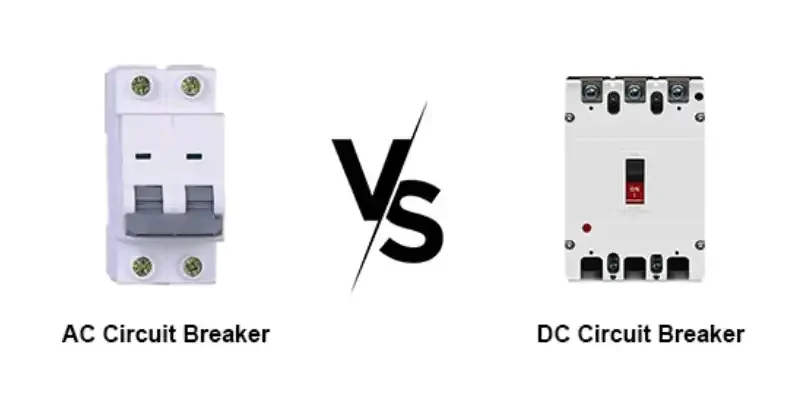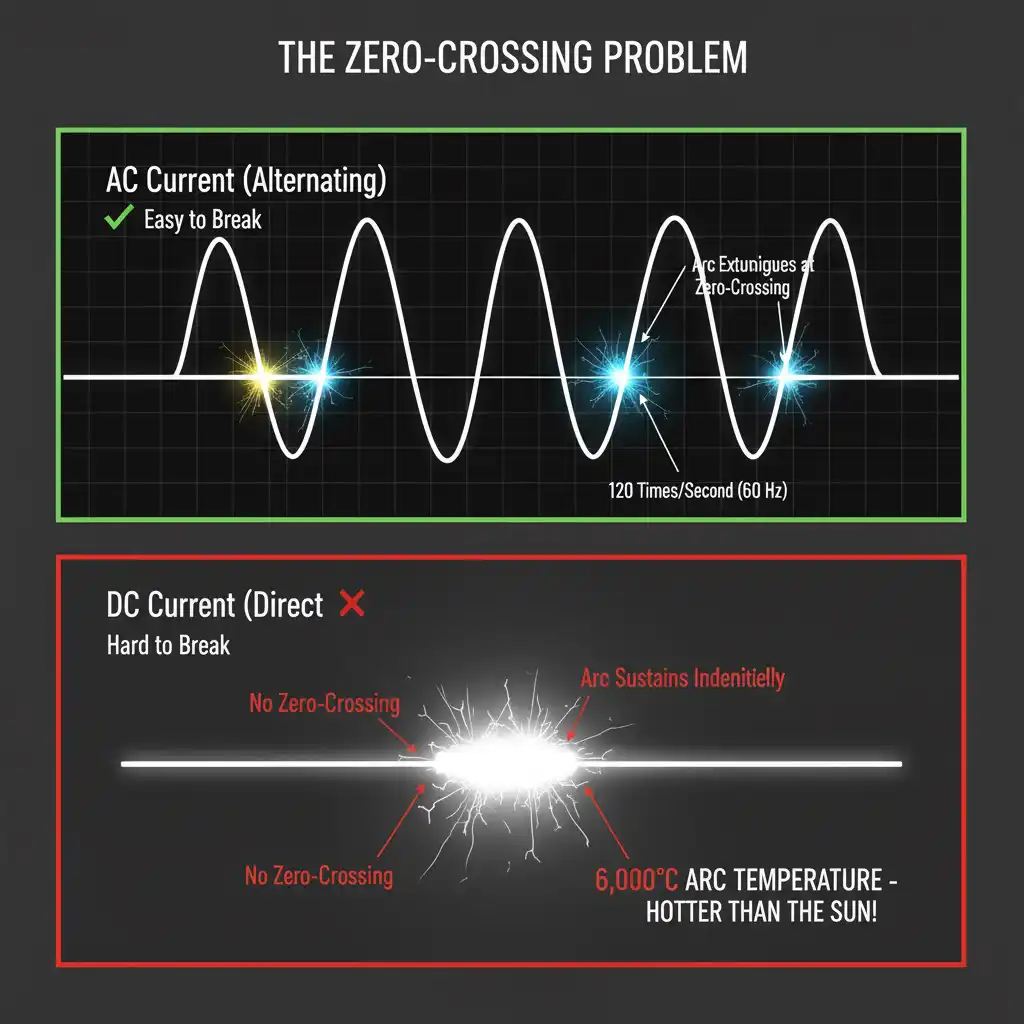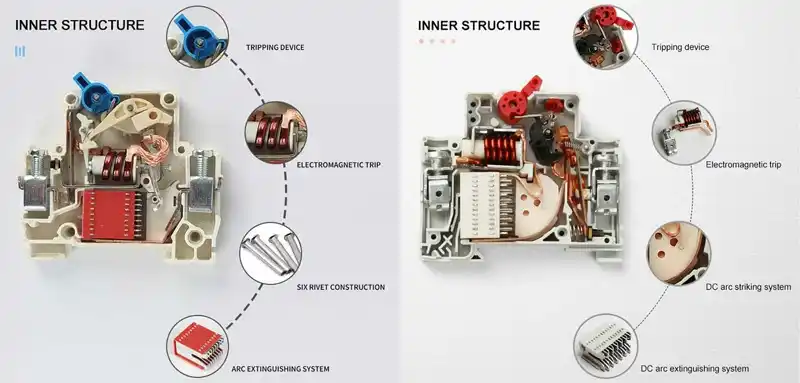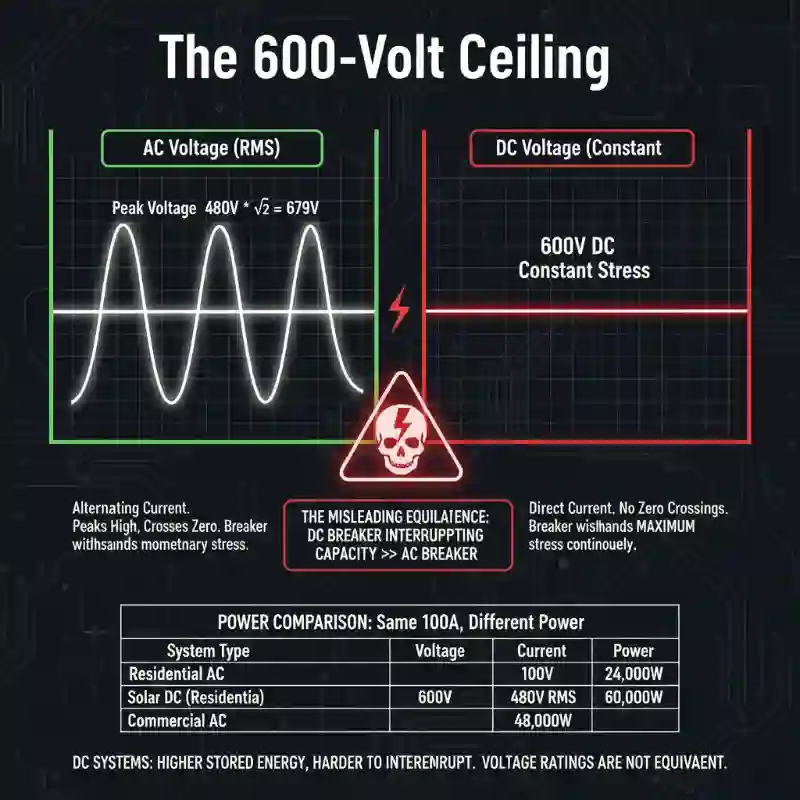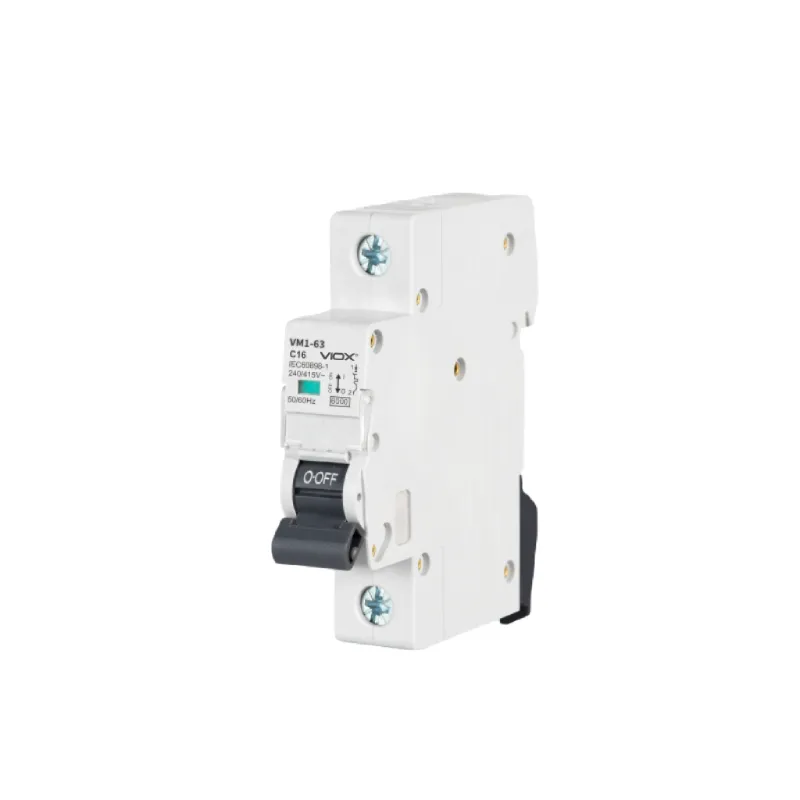The service call came in at 2 PM on a Tuesday. Routine solar panel inspection. Nothing unusual expected.
But when the technician opened the combiner box, he found something that made his stomach drop: the DC circuit breaker’s contacts had welded together—fused into a solid mass of copper. The breaker was supposed to protect the system. Instead, it had become a permanent short circuit.
Here’s what’s terrifying: The breaker never tripped during the fault. The arc that formed when the contacts tried to separate generated enough heat—over 6,000°C—to melt the copper before the breaker could interrupt the current. The system kept running, feeding power through what was essentially a glob of molten metal, until someone physically shut it down.
Why did this happen? Someone installed an AC-rated circuit breaker in a DC system. Same voltage rating. Same current rating. Completely wrong application.
That mistake cost $40,000 in damaged equipment and a week of downtime.
The difference between DC and AC circuit breakers isn’t just technical trivia—it’s the difference between protection and disaster.
Why DC Current Is Harder to Stop: The Zero-Crossing Problem
Think about how water flows through a pipe versus how it pulses through a pressure washer. That’s the difference between DC and AC current.
AC current alternates direction 50 or 60 times every second. In a 60 Hz system, the current crosses through zero voltage 120 times per second—twice per cycle. When a circuit breaker’s contacts separate and an arc forms, that arc extinguishes naturally at the next zero crossing. The breaker just needs to prevent the arc from re-striking. It’s working with the physics of alternating current.
DC current flows in one continuous direction with steady voltage. There are no zero crossings. Ever.
When contacts separate in a DC circuit, the arc forms and just… stays there. It doesn’t care about your breaker’s attempt to interrupt it. That arc will continue until something physically breaks it, cools it, or stretches it beyond sustainability.
The numbers make this brutally clear: A typical AC arc extinguishes within 8 milliseconds (1/120th of a second) thanks to natural zero crossings. A DC arc? It can sustain indefinitely at temperatures exceeding 6,000°C—hotter than the surface of the sun, and well above copper’s melting point of 1,085°C.
This is what I call “The Zero-Crossing Problem.” AC breakers can rely on physics to help them. DC breakers have to fight physics every step of the way.
The practical impact: DC breakers need aggressive arc-extinction mechanisms. Magnetic blowout coils that literally blow the arc apart. Special contact geometries that stretch the arc until it cools and breaks. Arc chutes filled with insulating plates that split the arc into smaller, easier-to-extinguish segments. Some advanced DC breakers even use vacuum chambers or sulfur hexafluoride gas to quench arcs faster.
All of this complexity exists to solve one problem: DC current is stubborn. It refuses to let go.
What Makes DC Breakers Different (And More Expensive)
Inside of AC MCB VS DC MCB
Walk into an electrical supply house and compare prices. A standard 20A, 120V AC circuit breaker: $15. A 20A, 125V DC circuit breaker: $80-120.
Same current rating, similar voltage, but the DC breaker costs 5-8 times more.
Engineers love to complain about this price difference. “It’s just a switch!” they say. But here’s what’s inside that “just a switch”:
In an AC breaker:
- Two main contacts (line and load)
- Basic thermal-magnetic trip mechanism
- Simple arc chute with a few metal plates
- Single pole construction
In a DC breaker:
- Three or more main contacts arranged in series
- Enhanced thermal-magnetic trip mechanism with higher magnetic force
- Complex arc chute with dozens of steel plates
- Magnetic blowout coils that consume extra space
- Special contact materials (silver-tungsten alloys instead of silver-nickel)
- Precise air gap engineering (too small and the arc won’t elongate; too large and the breaker won’t fit in standard enclosures)
That price premium isn’t profit margin—it’s physics. Every component in a DC breaker has to work harder to overcome The Zero-Crossing Problem.
And here’s the kicker: You cannot substitute one for the other, even if voltage and current ratings match. An AC breaker in a DC system won’t interrupt high-energy faults. The arc will sustain, contacts will weld, and your “protection device” becomes an uncontrolled conductor.
I’ve seen this failure mode destroy $50,000 of solar equipment when an installer tried to save $60 on breakers.
The Arc Welding Effect—when breaker contacts fuse together—is frighteningly common in misapplied AC breakers on DC systems. Once contacts weld, the breaker is permanently closed. No amount of manual operation will separate them. You’re left with an always-on circuit that has no protection whatsoever.
The 600-Volt Ceiling: Why DC Ratings Are Deceiving
Here’s a question that trips up even experienced engineers: Why are residential DC systems limited to 600V, while AC systems commonly run at 240V or even 480V in commercial buildings?
The answer reveals something counterintuitive about electrical ratings.
Voltage ratings are not equivalent across AC and DC systems. A 600V DC circuit actually stores and can discharge more energy than a 480V AC circuit of the same current rating. Here’s why:
AC voltage is typically specified as RMS (Root Mean Square)—effectively an average value. A 480V AC system actually peaks at 679V (480V × √2) during each cycle, but only for an instant before dropping back toward zero. The breaker only needs to withstand that peak momentarily.
DC voltage is constant. A 600V DC system maintains 600V continuously—no peaks, no valleys, no zero crossings to help with interruption. The breaker faces maximum stress at all times.
This is “The 600-Volt Ceiling”: the National Electrical Code’s limit for residential DC installations. Above 600V DC, you’re in commercial/industrial territory with stricter requirements for cable routing, labeling, and qualified personnel. Meanwhile, AC systems can reach 480V in commercial buildings without triggering the same restrictions.
Let’s make this concrete with power comparison:
| System Type | Voltage | Current | Power |
|---|---|---|---|
| Residential AC | 240V RMS | 100A | 24,000W |
| Solar DC (Residential) | 600V | 100A | 60,000W |
| Commercial AC | 480V RMS | 100A | 48,000W |
Same current rating (100A), but wildly different power levels. This is why DC breaker interrupting capacity specifications look so extreme. A 600V DC breaker might need a 25,000A interrupting capacity where a 240V AC breaker only needs 10,000A for the same application.
⚡ Pro Tip: When sizing DC breakers for solar systems, always account for temperature-corrected open-circuit voltage (Voc). A 48V nominal battery system might see 58V at full charge. A solar string rated for 500V might produce 580V on a cold winter morning when panel efficiency peaks. Round up generously on voltage ratings—it costs a few dollars more but prevents catastrophic failures.
How to Select the Right Circuit Breaker: 5-Step Method
Let me walk you through the systematic approach that prevents the $40,000 mistakes I mentioned earlier.
Step 1: Identify Your Current Type
DC systems:
- Solar photovoltaic panels (always DC output)
- Battery storage systems (batteries are DC by nature)
- Electric vehicle charging stations (battery side is DC)
- Industrial DC motor drives
- Telecommunications equipment
- Railway electrification (often DC)
AC systems:
- Grid power from utilities (residential/commercial)
- Motor control for AC induction motors
- HVAC systems
- General building electrical distribution
- Most appliances and lighting
Mixed systems (requires both types):
- Solar + battery systems with grid connection
- EV charging (AC input, DC to vehicle)
- Uninterruptible Power Supplies (UPS)
- Variable frequency drives (AC input, DC bus, AC output)
For mixed systems, you’ll need appropriate breakers on each side. The solar-to-battery connection needs DC breakers. The grid connection needs AC breakers. Never cross them.
Step 2: Calculate Maximum Voltage Requirements
For DC systems:
Calculate open-circuit voltage with temperature correction. Solar panels increase voltage in cold weather—sometimes by 25% or more.
Formula: Voc(cold) = Voc(STC) × [1 + (Tcoeff × ΔT)]
Example: 48V nominal solar array
- Voc(STC) = 60V @ 25°C
- Temperature coefficient = -0.3%/°C
- Coldest ambient = -10°C
- ΔT = 25°C – (-10°C) = 35°C
- Voc(cold) = 60V × [1 + (-0.003 × 35)] = 60V × 1.105 = 66.3V
Your breaker must be rated for at least 66.3V—not 60V, not 48V nominal. Round up to standard rating: 80V DC breaker minimum.
For AC systems:
Use nameplate voltage. Standard ratings are fixed: 120V, 240V, 277V, 480V, 600V AC. Match or exceed your system voltage.
Step 3: Determine Current Rating (With Proper Derating)
DC breakers for solar/battery:
Current rating = Isc(max) × 1.25 (NEC 690.8 requirement)
Example: Solar array with short-circuit current (Isc) = 40A
- Required breaker rating = 40A × 1.25 = 50A minimum
- Standard sizes: 50A, 60A, 70A → Select 50A breaker
AC breakers for continuous loads:
Current rating = Load Current × 1.25 (NEC 210.20 requirement)
Example: 30A continuous HVAC load
- Required breaker rating = 30A × 1.25 = 37.5A
- Standard sizes: 30A, 35A, 40A → Select 40A breaker
Temperature derating: If your breaker operates above 40°C ambient (common in solar combiner boxes), apply additional derating. For every 10°C above 40°C, derate by approximately 15%.
Example: 50A breaker in 60°C combiner box
- Temperature excess = 60°C – 40°C = 20°C
- Derating factor = 0.85 × 0.85 = 0.72
- Effective capacity = 50A × 0.72 = 36A
If your calculated load requirement is 40A, that “50A” breaker won’t cut it. You’d need a 60A breaker to get effective capacity of 43.2A.
Step 4: Check Interrupting Capacity (The Most Overlooked Spec)
Interrupting capacity (also called breaking capacity or short-circuit rating) is the maximum current the breaker can safely interrupt without exploding, welding contacts, or causing cascading failures.
This is where DC systems get scary.
Battery systems can source enormous short-circuit currents because batteries have almost zero internal impedance. A “small” 48V, 100Ah lithium battery bank can deliver 5,000A or more during a direct short circuit.
| System Type | Voltage | Typical Interrupting Capacity Required |
|---|---|---|
| 12V DC automotive | 12V | 5,000A @ 12V |
| 48V DC solar/battery | 48V | 1,500-3,000A @ 48V |
| 125V DC industrial | 125V | 10,000-25,000A @ 125V |
| 600V DC solar array | 600V | 14,000-65,000A @ 600V |
| AC residential | 120/240V | 10,000 AIC typical |
| AC commercial | 480V | 22,000-65,000 AIC |
Notice how DC interrupting capacities are similar or higher than AC, even though DC systems typically handle lower voltages? That’s The Stubborn Current at work. DC faults are harder to interrupt, so breakers need more breaking capability.
⚡ Pro Tip: For battery systems, use the battery manufacturer’s maximum discharge current specification, not the nominal current. A battery rated for 100A continuous might source 500A during faults. Your breaker’s interrupting capacity must exceed that fault current.
Step 5: Verify Code Compliance (NEC Requirements)
DC systems (NEC Article 690 for PV, Article 706 for energy storage):
- Voltage limits: 600V DC maximum in residential (one- and two-family dwellings)
- Circuit protection required for all conductors exceeding 30V or 8A
- Metal raceway or Type MC cable required for indoor DC circuits over 30V
- Labeling required: “PHOTOVOLTAIC POWER SOURCE” or “SOLAR PV DC CIRCUIT” on all DC enclosures
- Ground-fault protection required for roof-mounted PV systems
- Rapid shutdown requirements (module-level or array-level shutdown within 30 seconds)
AC systems (NEC Article 210 for branch circuits, Article 240 for overcurrent protection):
- AFCI (Arc-Fault Circuit Interrupter) required for most 120V dwelling unit circuits
- GFCI (Ground-Fault Circuit Interrupter) required for wet locations, kitchens, bathrooms, outdoor outlets
- Tandem breakers (double breakers in single space) allowed only where panelboard is rated for them
- Breakers must be listed (UL 489) for branch circuit protection
UL Standards matter:
- UL 489: Full branch circuit protection (highest rating, required for standalone circuits)
- UL 1077: Supplementary protection (for use within equipment only, not standalone)
- UL 2579: Specific to PV DC arc-fault circuit protection
Never substitute a UL 1077 supplementary protector where UL 489 branch circuit protection is required. They’re not equivalent.
Where Each Type Belongs (And Where They Don’t)
DC Circuit Breaker Applications
Solar photovoltaic systems – This is where DC breakers are absolutely non-negotiable. Every string needs DC-rated breakers. Every combiner box. Every connection from panels to charge controller to battery to inverter (on the DC side). The National Electrical Code requires it. Physics demands it.
I worked on a project where the installer used $15 AC breakers instead of $80 DC breakers to save money on a 50kW solar array. Six months later, during a ground fault, one breaker welded shut and fed fault current continuously until the DC cable’s insulation burned through.
Total repair cost: $35,000. The “savings” cost 400 times more than the correct breakers would have.
Electric vehicle charging infrastructure – The DC side (from charger to vehicle battery) requires DC breakers rated for the battery voltage. Level 3 DC fast chargers operate at 400-800V DC with currents exceeding 200A. These are brutal conditions. The AC supply side (from utility to charger) uses standard AC breakers.
Battery energy storage systems – Lithium battery banks are DC by nature. Every connection needs DC breakers rated for the bank voltage and—critically—for the enormous short-circuit current batteries can source. A 48V, 10kWh residential battery bank can dump 5,000A+ into a short circuit. Your breaker must handle that interrupting capacity.
Telecommunications – Cell towers, data centers, and telecom facilities run on DC power (typically 48V) because DC is more reliable and doesn’t have the power factor issues of AC. All protection on the DC distribution side must be DC-rated.
AC Circuit Breaker Applications
Residential and commercial building distribution – Your home’s main panel, all branch circuits for outlets and lighting, appliance circuits—these are all AC. Grid power is AC, so building distribution is AC. Use standard AC breakers rated for 120V, 240V, or 277V (for commercial lighting).
AC motor control – Induction motors, HVAC compressors, pump motors—these run on AC power. The motor starter or VFD receives AC input, so use AC breakers for supply protection.
Grid-connected inverter AC output – Solar systems with grid-tie inverters produce AC output on the utility-facing side. That connection to your main panel uses AC breakers. The solar array itself is DC (DC breakers), but once the inverter converts to AC, you’re in AC breaker territory.
Where You Need BOTH
Hybrid solar systems with battery backup require DC breakers on the PV array side, DC breakers on the battery connections, and AC breakers on the grid-tie and load-side AC circuits. A typical residential system might have:
- DC breakers: 4-6 (PV strings + battery charge/discharge)
- AC breakers: 2-3 (inverter AC output + grid connection + critical loads backup)
Common Mistakes (And How They Fail)
Mistake #1: “Close Enough” Voltage Ratings
Engineer’s thinking: “My 48V nominal system peaks at 58V, so a 60V DC breaker should work.”
Reality: That 48V system can hit 66V on a cold morning when the solar panels operate at maximum efficiency. The 60V breaker sees overvoltage conditions, arc extinction performance degrades, and you’re pushing the breaker beyond its tested safety margin.
Fix: Always use the temperature-corrected Voc for solar systems. Round up to the next standard breaker voltage rating. It costs $10-20 more. It’s worth it.
Mistake #2: Using AC Breakers in DC Systems
This is the $40,000 error I keep referencing. An AC breaker simply cannot interrupt DC arcs reliably. The absence of zero crossings means the arc sustains, contacts overheat, and welding occurs.
Fix: Never, ever cross-apply. DC systems get DC breakers. AC systems get AC breakers. If you’re unsure, look at the breaker label. It will explicitly state “DC” or “AC” ratings. If it only lists AC ratings, don’t use it on DC circuits.
Mistake #3: Ignoring Interrupting Capacity
Current rating ≠ interrupting capacity. A 100A breaker might only have 5,000A interrupting capacity. If your battery bank can source 10,000A during a short circuit, that breaker cannot safely interrupt the fault. The breaker may explode (yes, literally) or fail catastrophically.
Fix: Calculate available short-circuit current for your system. For battery systems, use the manufacturer’s maximum discharge spec. Select breakers with interrupting capacity exceeding your fault current.
Mistake #4: Forgetting Temperature Derating
Solar combiner boxes often reach 60-70°C in direct sun. Your “50A” breaker might only be rated for 36A effective capacity at that temperature.
Fix: Either oversize your breaker to account for temperature derating, or improve ventilation in your enclosure. Some installers use thermally insulated combiner boxes with forced ventilation to keep temperatures closer to 40°C.
The Future: Smart DC Breakers
Here’s something most engineers don’t realize yet: We’re entering the era of solid-state circuit breakers, and DC systems will benefit first.
Traditional electromechanical breakers rely on physical contacts separating. Solid-state breakers use power semiconductors (MOSFETs or IGBTs) to interrupt current electronically—no moving parts, no arcs, no contact welding.
For AC systems, solid-state breakers are nice-to-have. For DC systems? They’re transformational.
A solid-state DC breaker can interrupt a 600V, 100A fault in under 1 millisecond—100 times faster than electromechanical breakers. No arc, no heat, no contact erosion. They can cycle millions of times without degradation. They can implement advanced protection algorithms, communicate status over networks, and adapt trip curves to system conditions.
The downside? Cost. A solid-state DC breaker might run $300-800 versus $80-120 for electromechanical. But for critical applications—utility-scale battery storage, data centers, military systems—that price is justified by reliability and performance.
UL 489 certification now covers solid-state circuit breakers, so we’ll see more adoption as costs decline. Within 5-10 years, I expect solid-state to become standard for DC systems above 200V.
The Bottom Line
The fundamental difference between DC and AC circuit breakers comes down to one merciless fact: DC current doesn’t want to stop.
AC current naturally crosses zero 120 times per second, giving breakers an assist. DC current flows continuously, fighting every attempt to interrupt it. That resistance to interruption shapes everything—from internal breaker design to selection criteria to cost to code requirements.
When you choose the right breaker for your application, you’re not just checking a box on an electrical plan. You’re building the last line of defense between normal operation and catastrophic failure. That defense must match the physics of your current type.
Use DC breakers for DC systems. Use AC breakers for AC systems. Never cross-apply.
If you’re designing a solar photovoltaic system, battery storage installation, EV charging infrastructure, or any DC application, invest in the correct DC-rated breakers with appropriate interrupting capacity. If you’re working with standard building electrical, grid power, or AC motor control, use AC breakers designed for that purpose.
And if you’re ever tempted to substitute one for the other to save $50? Remember the welded contacts, the $40,000 repair bill, and the week of downtime.
⚡ For VIOX DC and AC circuit breakers engineered for solar, battery, and industrial applications, contact our technical team for application-specific selection guidance and UL 489-certified solutions.
Frequently Asked Questions
Q: Can I use an AC circuit breaker in a DC system?
A: No. Using an AC circuit breaker in a DC system is dangerous and may not effectively interrupt fault currents. AC breakers rely on the natural zero crossings in alternating current to extinguish arcs. DC current has no zero crossings, so the arc sustains, potentially welding the contacts together. Always use DC-rated breakers for DC systems.
Q: Why are DC circuit breakers more expensive than AC breakers?
A: DC breakers require more complex internal mechanisms to overcome The Zero-Crossing Problem. They need magnetic blowout coils, multiple contact arrangements, specialized arc chutes with dozens of plates, and premium contact materials like silver-tungsten alloys. This additional complexity increases manufacturing costs by 5-8 times compared to AC breakers.
Q: What voltage ratings are available for DC circuit breakers?
A: DC circuit breakers range from 12V (automotive applications) to 1,500V DC (industrial and large-scale solar). Common ratings include 12V, 24V, 48V, 80V, 125V, 250V, 600V, and 1,000V DC. For residential solar, the maximum is typically 600V DC per NEC requirements.
Q: Do I need special training to install DC circuit breakers?
A: Yes, especially for systems above 50V DC or commercial applications. DC systems have unique safety requirements including cable routing, labeling, rapid shutdown, and ground-fault protection. High-voltage DC installations (above 600V) require qualified electrical professionals familiar with NEC Article 690 and Article 706.
Q: How do I calculate the right size DC circuit breaker for my solar system?
A: Use the short-circuit current (Isc) from your solar panel datasheet and multiply by 1.25 per NEC 690.8. For voltage rating, calculate the temperature-corrected open-circuit voltage (Voc) at your coldest expected temperature. Always round up to the next standard breaker rating. Factor in temperature derating if your combiner box operates above 40°C.
Q: What’s the difference between UL 489 and UL 1077 ratings?
A: UL 489 is the highest safety standard for branch circuit protection—these breakers can be used as standalone protective devices in your electrical system. UL 1077 covers supplementary protectors designed for use within equipment only, not for branch circuit protection. For solar, battery, and building electrical systems, always specify UL 489-rated breakers.
Q: Can one circuit breaker work for both AC and DC applications?
A: Some breakers are dual-rated for both AC and DC, but the voltage and current ratings differ significantly between the two applications. A breaker might be rated 240V AC / 125V DC, meaning it can handle higher AC voltage but only lower DC voltage due to the arc extinction challenges. Always verify both the AC and DC ratings if using a dual-rated breaker, and never exceed either rating.
Q: What happens if I use the wrong type of circuit breaker?
A: Using the wrong breaker type can result in failure to interrupt fault currents (leading to fire hazards), Arc Welding Effect (contacts fuse together permanently), equipment damage, code violations, and potential injury. In the opening scenario of this article, using an AC breaker in a DC system caused $40,000 in damage. The correct breaker selection is absolutely crucial for safety and reliable protection.

